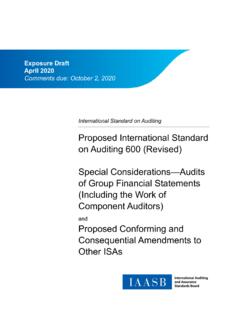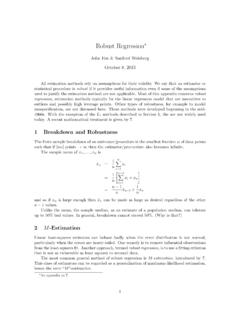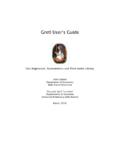Transcription of Guide: The Complete Guide to API 2350, 5th Ed.
1 The Complete Guide to API 2350, 5th An Introduction to API 235006. Motivating robust Overfill Protection09. Implementation of API 235012. Operating Parameters18. Equipment and Operations19. Automated Overfill Prevention System (AOPS)21. Summary and Conclusions22. Appendix A. Equipment Solutions B. API 2350 Compliance Checklist C. Frequently Asked Questions3An Introduction to API 2350 Tank overfills are a major concern to the petroleum industry. The best case scenario is that you have to clean it up. The worst case scenario involves going out of business, and ending up in court. As a response to this, the industry has worked jointly to create the API Standard 2350: Overfill Protection for Storage Tanks in Petroleum Facilities . This standard is a description of the minimum requirements required to comply with modern best practices in this specific application.
2 Obviously the main purpose is to prevent overfills, but another common result of applying this standard is increased operational efficiency and higher tank 2350 was created by the industry for the industry with contributions from a wide range of industry representatives including: tank owners and operators, transporters, manufacturers, and safety experts. This together with the fact that it singles out a specific application (non-pressurized above ground large petroleum storage tanks) and a specific use-case (overfill prevention) make this standard unique. It does not compete with other more generic safety standards , but is intended as compliment them. Using Safety Instrumented Systems (SIS) designed in accordance with IEC61511 is one example of how to fulfill some of the requirements in API industry adoption rate to this standard is expected to be very high because of its obvious benefits, combined with the world s ever-increasing need for more safety.
3 The question for a tank owner or operator is whether they can afford not to implement API 2350. Because of the standard s generic nature, it is expected to also be applicable to nearby tanks outside the standard s specific scope, containing, for example, chemicals or Class 31 petroleum operations are similar across the world, and many companies operate in a multinational environment. API 2350, despite the reference to America , has been written from an international perspective. Thus, it is intended to be equally valid and applicable Guide will provide the basic elements needed for a petroleum tank owner/operator to apply the API 2350 to new or existing tank facilities with minimal effort and maximal gains. You should read it because this new standard is expected to become a game-changer within overfill prevention, and by reading your company can also reap the benefits that come from applying the latest best practices.
4 The standard itself is available for a small fee from API s web site ( ).1 NFPA National Fire Protection Association. Class 1 liquids have flash points below 100 F . Class 2 liquids have flash points at or above 100 F and below 140 F. Class 3 liquids have flash points above 140 target audience for this Guide are owners and operators of fuel distribution terminals, refineries, chemical plants and any other facilities which receive petroleum or chemical products into storage. Anyone responsible for safe operations at fuel marketing, distribution terminals, refineries, oil handling, or pipeline companies should take advantage of the state of art in tank overfill prevention that will be discussed in this Guide . While the scope of API 2350 applies to the filling of petroleum-based products associated with marketing, refining, pipeline and terminal facilities, its principles may be applied to any tank operation where there is a risk of overfilling the applications under API 2350 involve atmospheric or slightly pressurized tanks, but the principles of API 2350 can be used for higher pressure storage as well.
5 The scope of API 2350 applies to overfill protection for NFPA2 Class 1 and Class 2 liquids and is also recommended for compliance regarding Class 3 liquids. The Scope of API 2350 (see below) presents a more detailed breakdown. For flammable liquids classified by fire codes (Class 1 liquids) API 2350 can mitigate the likelihood of spilling these hazardous products and the likely resulting facility fire. Since spills of non-volatile organic liquids such as lube oils or heavy asphaltic products are often considered an environmental hazard, overfills of these products are also addressed by the API 2350 standard. 2 NFPA National Fire Protection Association. Class 1 liquids have flash points below 100 F . Class 2 liquids have flash points at or above 100 F and below 140 F. Class 3 liquids have flash points above 140 of API 2350 API 2350 applies to petroleum storage tanks associated with marketing, refining, pipeline, terminals and similar facilities containing Class I or Class II petroleum liquids.
6 API 2350 recommends including Class III 2350 does not apply to: Underground storage tanks Above ground tanks of 1320 US gallons (5000 liters) or less Above ground tanks which comply with PEI 600 Tanks (process tanks or similar flow through tanks) that are integral to a process. Tanks containing non-petroleum liquids Tanks storing LPG and LNG Tanks at Service Stations Loading or delivery from wheeled vehicles (such as tank trucks or railroad tank cars) PEI RP 600 Recommended Practices for Overfill Prevention regarding Shop-Fabricated Above Ground Tanks for overfill protection where applicable for above ground tanks falling outside the scope of API generation of API 2350 The API 23503 standard applies to filling tanks with petroleum-based products for the purpose of preventing overfills.
7 The current edition of API 2350 builds on best practices from both the petroleum industry and from other industries and applies them directly to tank overfill protection. A key and influential event that shaped later editions of API 2350 was the Buncefield conflagration arising from a petroleum tank overfill at the Hertfordshire Oil Storage Terminal (HOSL) near Heathrow Airport. On December 11th 2005, the fire engulfed 20 tanks resulting in the total destruction of the terminal and nearby facilities. This fire was the worst in Europe since World War II. The Buncefield incident was also one of the most intensely studied tank overfill events of all time. Fortunately, the lessons learned from this incident have been captured by the United Kingdom s HSE4 in reports5 covering this incident. API 2350 represents today s minimum best practices so tank owners and operators can now prepare for what will undoubtedly be the benchmark for generally recognized good practice in the petroleum storage from past experiencesThe following quote from the United Kingdom s Health Safety Executive Buncefield investigation shows unsurprisingly, that faults in management systems are a key root cause of tank overfill incidents.
8 Management systems in place at HOSL relating to tank filling were both deficient and not properly followed, despite the fact that the systems were independently audited. Pressures on staff had been increasing before the incident. The site was fed by three pipelines, two of which control room staff had little control over in terms of flow rates and timing of receipt. This meant that staff did not have sufficient information easily available to them to manage precisely the storage of incoming fuel. Throughput had increased at the site. This put more pressure on site management and staff and further degraded their ability to monitor the receipt and storage of fuel. The pressure on staff was made worse by a lack of engineering support from Head Office. Unfortunately, the scenarios described above leading to this incident are all too common.
9 But fortunately, the API Committee developing the new API 2350, fully integrated the lessons learned from Buncefield as well as other incidents and combined them with the best practices for tank filling operations from every sector of the petroleum industry. The API committee is a consensus-based standards development organization and the current edition of API 2350 ensures a worldwide perspective on tank overfill protection. The worldwide best practices from different; countries, regulatory agencies, and companies have been studied and compiled into the API 2350 Overfill Protection for Storage Tanks in Petroleum Facilities, ANSI/API Standard 2350-2012, Fifth Edition, September 20204 HSE Health Safety Executive is a governmental safety agency in the United Kingdom responsible for public and worker health and safety5 liabilitiesClearly, the prevention of overfills is a significant and obvious benefit to tank owners/operators.
10 All tank owners/operators know that protection of the public and workers health and safety, the environment, and assets are important. But what may not be so obvious to them is that the benefits that can result by applying the latest thinking related to tank overfills. The new management system practices encouraged by API 2350 may actually improve the normal day-to-day operations and efficiency for a facility. Tank overfills are relatively rare events so why are these rare events of concern? The reason is that the consequences of overfills can exceed most, if not all other potential scenarios at a petroleum facility. While rare, serious incidents usually yield risks to the tank owners/operators that are deemed unacceptable. The fact that there may be property damages, injuries or even fatalities is only the beginning of the accident scenario.
















